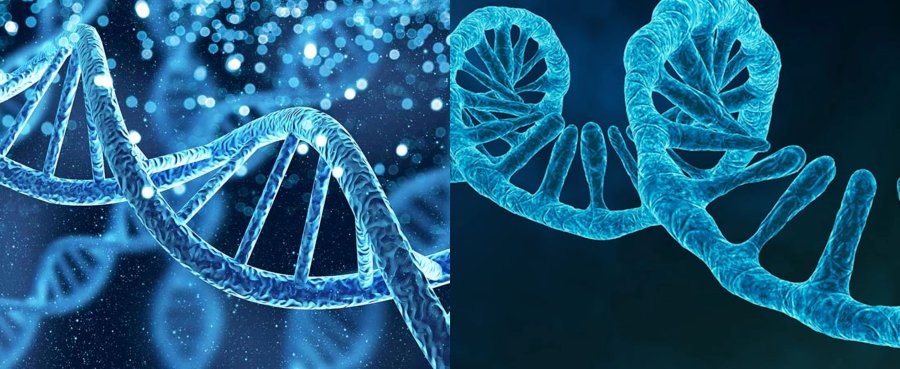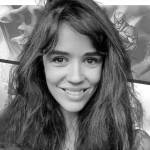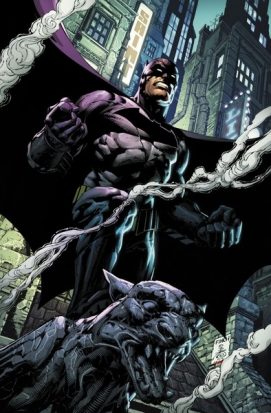Related Resources
Both DNA and RNA are nucleic acids that store our genetic information. However, the two have some major differences! For one: DNA has a half-life of 521 years while RNA’s lasts only two minutes.
This means that half of the bonds within DNA last a whopping 521 years, while RNA lasts only two minutes! And this isn’t the only difference between DNA and RNA.
In this DNA vs. RNA blog post, we’re going to find out what each nucleic acid is made of, what they’re responsible for and how one differs from the other.
Now, let’s explore the exciting world of genetics, shall we?

DNA vs. RNA — Function
DNA and RNA are both nucleic acids that store our genetic information.
Thanks to DNA and RNA, we transfer genetic information from one generation to the next. So, for example, if you have curly hair, that means one or both of your parents passed down the curly hair gene trait to you. And that process was possible thanks to nucleic acids.
DNA stands for deoxyribonucleic acid — a molecule that contains information on how all living organisms should develop and function. This not only goes for humans, but also everything from bacteria to monkeys and wasps.
RNA is the ribonucleic acid that’s indispensable for passing on genetic information stored within DNA and translating genes into proteins. In other words, it’s the driving force of your body.
Even though some people see RNA as just the messenger, this nucleic acid is far more than that — it carries genetic material like DNA and is essential for creating proteins.
DNA is like Batman while RNA is like Robin by his side. DNA knows what, when, and how something needs to be done, but it can’t communicate with anyone outside of its safe bubble — enter RNA.
Our bodies copy a DNA sequence of a gene to make RNA during a process called transcription. The RNA can then take on one of three possible forms:
- Messenger RNA or mRNA: Messenger RNA carries DNA’s genetic code from the nucleus to the ribosomes — small organelles essential for protein synthesis. They are located in the cytoplasm.
- Ribosomal RNA or rRNA: Ribosomal RNA is a part of ribosomes. Its task is to translate instructions mRNA carries into proteins.
- Transfer RNA or tRNA: Transfer RNA facilitates the process of protein synthesis by delivering amino acids to ribosomes. Amino acids are small molecules that build proteins.
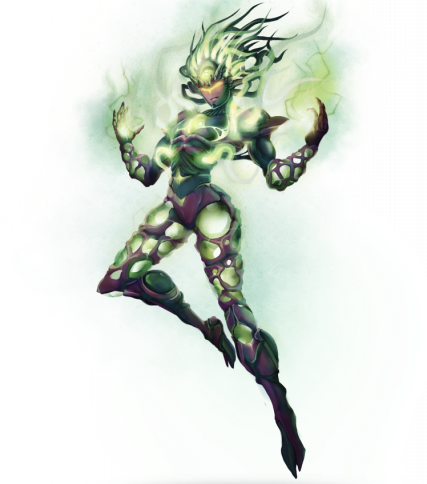
DNA vs. RNA — Structure
Structure-wise, DNA and RNA are very different.
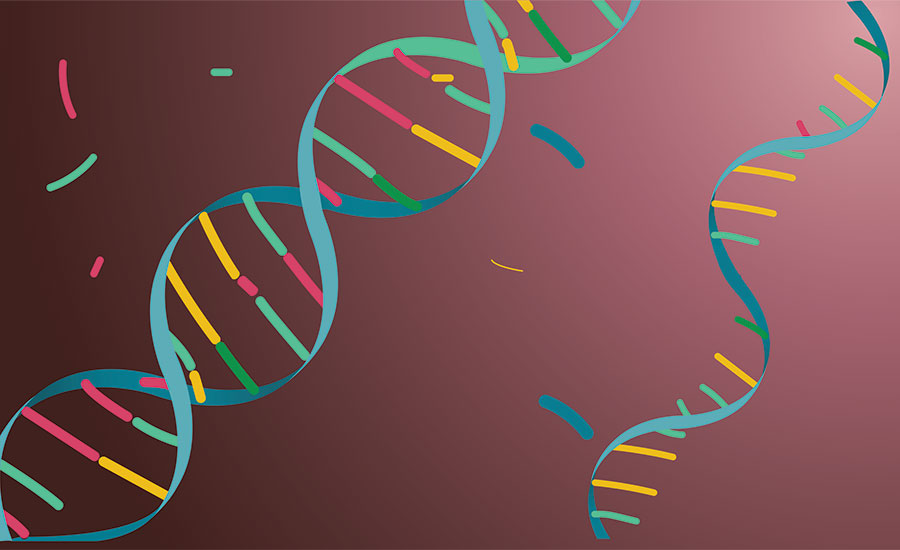
DNA consists of two strands that form the recognizable helix.
Now, the strands are made up of small molecules called nucleotides.
Each nucleotide is comprised of:
- Sugar molecule with five carbon atoms
- A phosphate group
- Nitrogenous bases
Sugar molecules are like the sugar you use to sweeten your food.
A phosphate is a form of phosphorus, most commonly used in fertilizers, but also in cosmetics, food and electronics in the form of phosphoric acid. Sugar and phosphates are the backbones of each DNA strand.
Both sugar and phosphate molecules are water-soluble, but the bases dislike water — they are hydrophobic. The nitrogenous bases try to stay dry in the water-filled cells, so they group together to form hydrogen bonds between the two strands.
On the other hand, RNA contains a single, short strand of ribonucleotides.
RNA can form a double-stranded helix, but only for a while. For instance, this happens briefly when a DNA gene sequence is copied and transcribed into RNA.
RNA nucleotides are made of:
- Sugar with five-carbon atoms
- A phosphate group
- Nitrogenous bases
There are seemingly no differences in the composition of DNA and RNA chains, but there is more to this than meets the eye!
Can you guess what other differences are?
Continue reading to find out!
DNA vs. RNA — Location
The cells in your body are small, but they can accommodate a two-meter-long DNA.
How is that even possible?
Your DNA is tucked away within the cell nucleus, safe and protected from potential outside danger.
But to make DNA fit inside of the nucleus, your body packs the nucleic acid into chromosomes — the dense, thread-like DNA bundles that form after DNA pairs up with a protein called chromatin. This protein helps squeeze the long DNA into a small space within the nucleus. At the same time, histones — another type of protein — keep the DNA structure compact. During the process of meiosis — a type of cell division, the chromosomes are decondensed, duplicated and then separated. That makes the end result of cell division — a gamete, i.e. sex cell unique, ensuring life on Earth stays so diverse!
Aside from the cell nucleus, a small part of DNA also lives within mitochondria — the organelles that infuse the cells with energy.
As for RNA, the body produces it inside the nucleolus — the largest structure within the nucleus. Unlike DNA, which stays within the nucleus forever, RNA travels to the cytoplasm to carry DNA instructions so your cells can start making proteins.
DNA vs. RNA — Bases
Both DNA and RNA contain four nitrogenous bases, each attached to sugar molecules, but their bases aren’t the same.
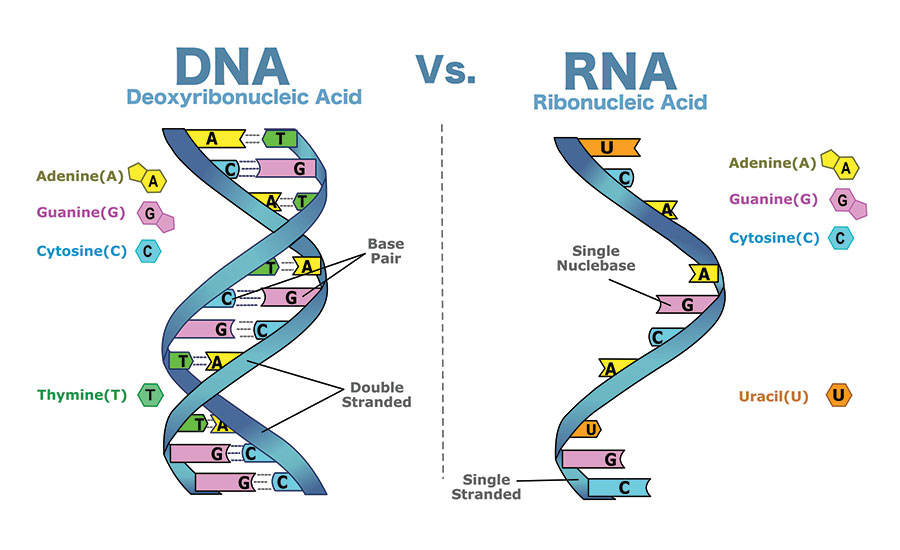
The four DNA bases are:
- Adenine (A)
- Thymine (T)
- Guanine (G)
- Cytosine (C)
We mentioned earlier that these guys want to stay dry, which could be a problem since the body’s cells are filled up with water. To solve the issue, the aquaphobic squad remains on the inner side, between the two strands.
The bases then interlink, forming the recognizable double helix. Adenine binds with thymine, while guanine interlinks with cytosine, producing a three-dimensional helix that contains all of our genetic details. Hydrogen bonds ensure minimal exposure to water, which is important for keeping DNA healthy — water sometimes contains molecules that can harm DNA.
The order of the nitrogenous bases determines the type of instructions DNA holds. But to translate those instructions into the language our cells can understand, DNA needs to make proteins. And to do that, it needs RNA!
The DNA sequence that contains specific instructions is called a gene. The rest of DNA holds information about when and where to make proteins.
RNA also packs four bases similar to those found in DNA, however, it doesn’t contain thymine! Instead, it includes:
- Adenine (A)
- Cytosine (C)
- Uracil (U)
- Guanine (G)
Adenine pairs with uracil while cytosine bonds with guanine, forming single-stranded chains.
DNA vs. RNA — Sugars
Both DNA and RNA strands include sugars with five atoms of carbon, but the sugars found in these nucleic acids aren’t the same.
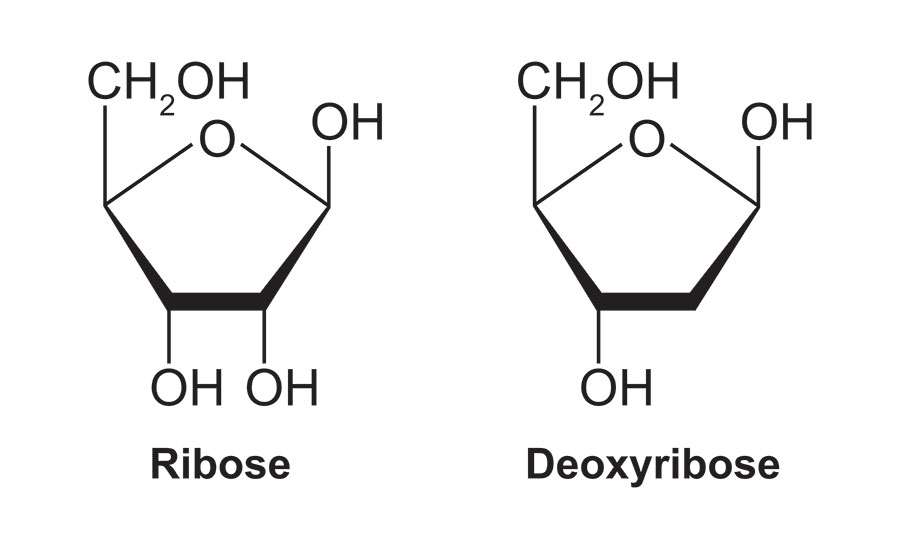
Both DNA and RNA strands include sugars with five atoms of carbon, but the sugars found in these nucleic acids aren’t the same.
DNA packs the deoxyribose, while RNA includes the sugar called ribose.
Ribose is a type of sugar your body naturally makes from glucose. It’s essential for the synthesis of RNA, but it’s also an important part of ATP — adenosine triphosphate. ATP is the key molecule that carries and transfers energy to cells.
Whenever you do things like run or kick a ball, your body needs power to perform those actions. And that energy comes from ATP!
Deoxyribose is a type of ribose that lacks one oxygen atom.
Both sugars are essential for the formation of the two nucleic acids. The interlink between sugars and phosphate groups provides a framework of both nucleic acids, with nitrogenous bases attaching themselves to sugars.
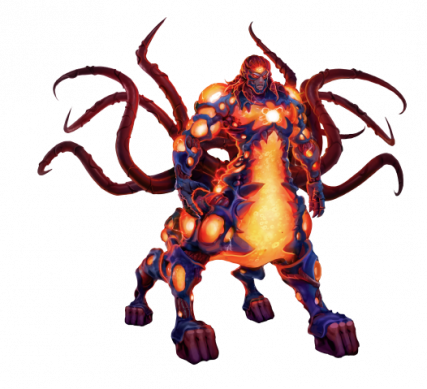
More Differences Between DNA And RNA
Aside from the main differences between DNA and RNA we listed above, the two nucleic acids also differ in some other aspects.
For example, DNA is susceptible to ultraviolet light damage, while RNA is more resistant.
If DNA continuously absorbs harmful UV light, it can mutate, which can lead to serious skin issues. UV rays can also cause damage to DNA indirectly by affecting melanin.
Melanin determines your skin, hair and eye color. When your skin is exposed to UV light, melanin can become reactive. If that happens, melanin can transfer its excitement to other molecules, such as oxygen. Now, oxygen loses its cool when it becomes too excited, so it tends to do whatever it takes to return to its low-energy state. That’s why it passes its energy onto other molecules it stumbles onto. If an excited oxygen molecule collides with DNA, it can damage it and cause mutations.
To prevent DNA damage from UV rays, you should always apply sunscreen!
When it comes to reactivity, DNA is more stable than RNA. This means that DNA is less likely to react to enzymes that might attempt to destroy it. Plus, your body naturally annihilates everything that poses a danger to DNA.
On the other hand, the sugar in RNA is highly reactive, making RNA more susceptible to enzyme attacks. Scientists are exploring what happens with RNA after it gets damaged. Sometimes, cells with the damaged RNA perform apoptosis, meaning they die. But recent research suggests that cells can also repair RNA damage!
DNA vs. RNA — Key Takeaways
DNA and RNA are arguably the most important molecules in all living organisms.
Even though there are several important differences between them, including their function, structural features, location and base pairings, they work as a team. Together, DNA, RNA and proteins make your cells function and make all life on Earth possible!

